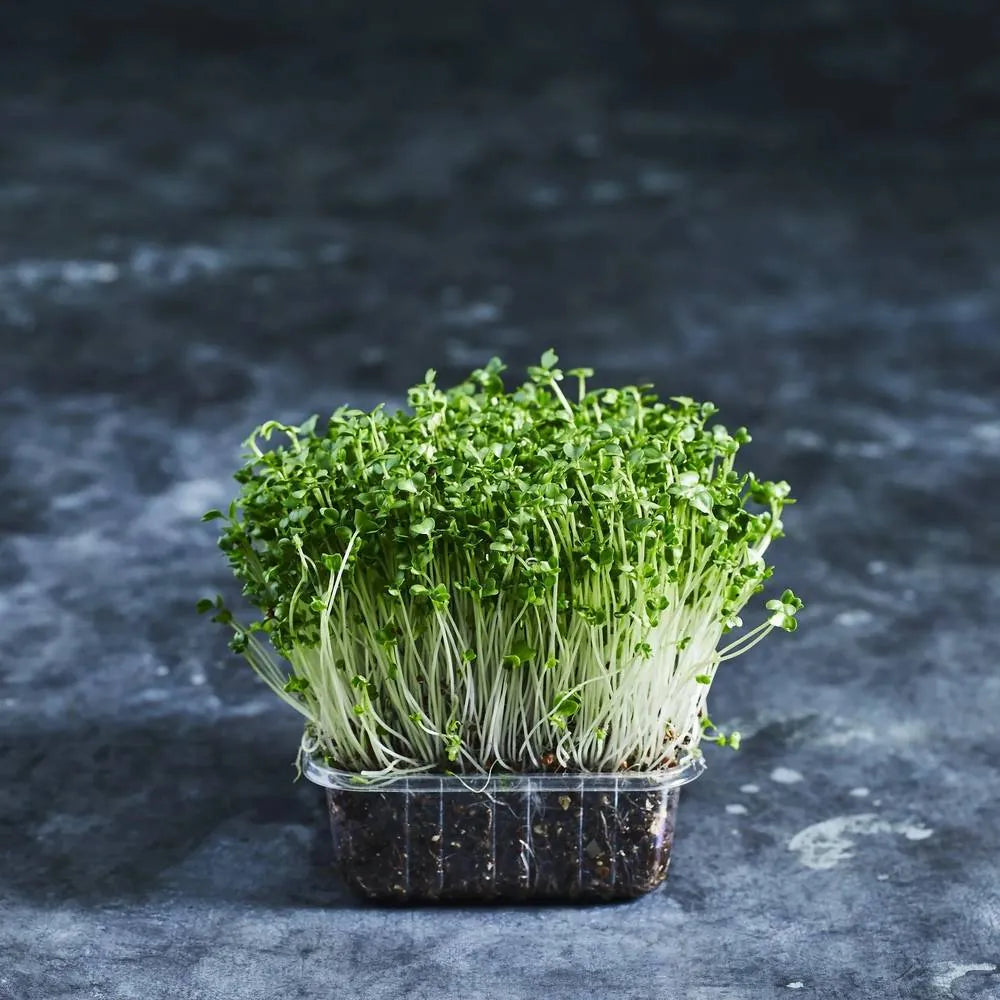Broccoli Microgreen Seeds Specifications
-
Brassica oleracea var. italica
- Variety – Calabrese & Green Sprouting
- Thousand Seed Weight – 2.3g
- Uses: Microgreens, sprouting, full maturity
- Status: Non-GMO, untreated
- Germination Rate: 95%
- Germination Time: 2–3 days
- Days to Harvest: 6–10 days (microgreens)
We have two premium seeds to. choose from:
- Type 1 – New Zealand Grown, Variety Calabrese, 95% germination rate. The cheaper option and every bit as good as the Australian variety below.
- Type 2 – Australian-Grown, Variety Green Sprouting, 96% germination rate. Slightly more expensive. A chance to support Australian farmers.
Grow Broccoli Microgreens At Home
Want to grow your own superfood in just days? Our Broccoli Microgreen Seeds are your ticket to fresh, homegrown nutrition that’s as easy as it gets. These tiny greens pack up to 10x more sulforaphane than mature broccoli, plus vitamins A, C, E, calcium, and iron. Perfect for smoothies, salads, stir-fries, or even your avo toast!
Learn more at our broccoli sprout guide, which covers everything broccoli sprouts, including handy little tips that you really should know.
How To Grow & Harvest Broccoli
1. Preparation
- Choose a shallow tray with drainage holes (20 cm × 20 cm works well).
- Fill with 3–4 cm of quality seed-raising mix, coir, or fine compost.
- Lightly press the surface to make a level seed bed.
- Moisten the medium so it’s damp but not waterlogged.
2. Seeding
- No pre-soaking is required for broccoli.
- Spread seeds evenly across the surface at about 8–10 g per 20 cm tray.
- Mist the seeds gently, then cover with a lid/tray or propagation dome.
3. Germination
- Keep trays out of the sun for the first 3 days.
- From days four and on, place your trays in a well lite sunny position otherwise they will grow tall and scrappy. If placed in too sunny a position, they will burn and wilt.
- Maintain temperatures between 16–26 °C for best results.
4. Light & Growth
- Once sprouts emerge, uncover the tray and move it to a bright, indirect light source or under grow lights.
- Ensure steady airflow to avoid fungal issues.
- Mist 1–2 times daily or bottom-water as needed, keeping the soil moist but never soggy.
5. Harvesting
- Broccoli microgreens are ready in 6–12 days when seedlings reach 5–7 cm tall with bright green leaves.
- Harvest in the morning for best crispness by snipping just above soil level with clean scissors.
- Use immediately, or store in a sealed container in the fridge for up to 7 days.
Growing Tip
Broccoli microgreens pair well with Green Daikon Radish and Purple Sango Radish. These varieties thrive under the same conditions and are easily grown and harvested together, making them perfect companions in your growing setup.
Live Rates – Weight & Destination Based
Shipping is automatically calculated at checkout based on your order’s weight and delivery address. We use real-time rates from Australia Post and other carriers to provide the most accurate cost.
Handling Time
Orders are packed and dispatched within 0–2 business days (Monday–Friday).
Estimated Delivery Time
Transit times depend on your location:
• Metro areas: usually 2–3 business days
• Regional/rural areas: 5–10 business days
• WA & TAS: may take longer due to state biosecurity inspections
Tracking
All orders include tracking. You’ll receive an email with your tracking link once your parcel has shipped.
Authority to Leave (ATL)
Couriers may leave parcels in a safe place if you are not home. Please provide delivery instructions at checkout if you prefer otherwise.
Pickup Option (Riverstone, NSW)
Please place your order on our website and select “Pick up” at checkout. Wait for us to contact you to confirm and arrange a pickup time. Do not come to our warehouse without an appointment — pickups are strictly by arrangement only. Allow 2–3 business days for preparation; we’ll notify you when your order is ready.
Biosecurity (WA & TAS)
Certain seeds are restricted under state biosecurity laws. Customers are responsible for ensuring products comply with local regulations. Please check with the WA Department of Primary Industries and Regional Development or the Tasmanian Department of Natural Resources and Environment before ordering.
For the full details, see our Shipping Policy.
No Change-of-Mind Returns
We do not accept returns or refunds for change-of-mind purchases.
No Exchanges
We do not accept product exchanges. All sales are final unless covered by Australian Consumer Law.
Your Rights Under Australian Consumer Law
Your ACL rights still apply. You’re entitled to a refund or replacement if your item is faulty, misdescribed, or incorrect. Please contact us within 7 days of delivery with your order number and photos if applicable. Once approved, we will provide a prepaid return label and process a refund or replacement. Refunds are issued to your original payment method within 10 business days.
90-Day Seed Germination Guarantee
If your seeds fail to germinate within 90 days of purchase, we will re-test the batch. If our test confirms poor germination, we will provide a refund or replacement. Seeds must be stored and used according to our instructions; please retain packaging or batch details if available.
For the full policy text you can also see our policy page at /policies/refund-policy.
Seed FAQ
Seeds don't expire, but their ability to sprout weakens over time. With proper storage, your seeds will remain viable for years, ensuring a high germination rate for every batch of fresh sprouts.
Key Storage Tips:
- ✅ Keep it Cool, Dry, and Dark: The best place to store seeds is in a location that's away from heat, light, and humidity.
- ✅ Use an Airtight Container: Jars or sealed bags are ideal. For extra protection against moisture, you can add a silica gel packet.
- ✅ Consider Refrigeration: For long-term storage, keeping seeds in the fridge or freezer is a great option. Just be sure to let them return to room temperature before you use them.
Sprouting Seed Viability Guide
Here's how long you can expect some of our most popular seeds to last when stored correctly:
- 1–2 Years: Mung beans, peas, lentils, and chickpeas.
- 3–4 Years: Alfalfa, radish, fenugreek, and mustard.
- 4–5 Years: Broccoli, wheatgrass, sunflower, buckwheat, and clover.
If you're unsure about older seeds, you can perform a simple germination test. Place a few seeds on a damp paper towel inside a sealed bag. Keep them moist and check the number of sprouts after 5–10 days to see if they are still viable.

